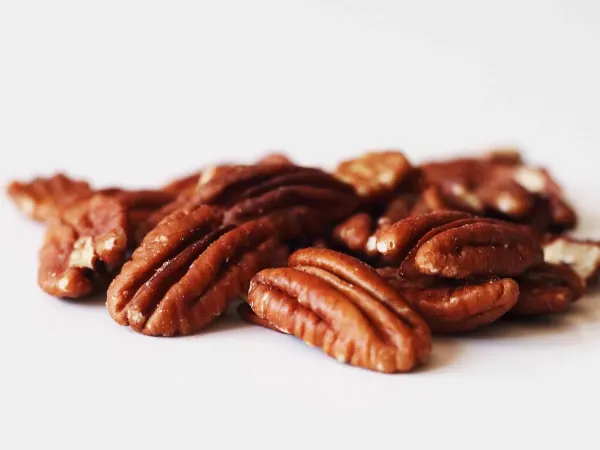Access our First Foods® Database in the Solid Starts App.
Learn morePecans
Tree Nut
Age Suggestion
6 months
Iron-Rich
Yes
Common Allergen
Yes

When can babies have pecans?
Pecans, if they are finely ground or served as pecan butter, may be introduced as soon as baby is ready to start solids, which is generally around 6 months of age. Whole pecans, chopped pecans, and pecan butter are choking hazards for babies and children, so read our preparation by age section closely before serving.
Pecans originated in North America, where they have grown on towering, long-lived trees that were first cultivated by Native Americans. While pecans grew wild in America for centuries, their success as a commercial crop owes much to someone known to the historical record only as Antoine, an enslaved man in Louisiana. Antoine’s reputation as an accomplished gardener led others to seek his expertise, and the trees he created through grafting formed the foundation of today’s pecan industry in the United States.
How do you serve pecans to babies?
Every baby develops on their own timeline, and the suggestions on how to cut or prepare particular foods are generalizations for a broad audience.
6 months old +:
Offer smooth pecan butter (honey free) thinned with water or finely grind pecans in a food processor until completely fine and no large pieces remain. If you do not have a food processor, you can pound the nuts in a cloth with a hammer, a mortar and pestle, or the end of a wine bottle until finely ground. To serve the ground nut, sprinkle a little into warm cereal or onto slippery foods like mango pits or avocado slices. When serving pecan butter, spread a very thin layer onto other age-appropriate foods. You can thin it with breast milk, formula, water, or foods like applesauce or yogurt before using as a spread to further reduce the choking risk. You can also spread the thinned-out pecan butter very thinly on toast strips. Try serving with a drink in an open cup to help wash down any sticky pieces of food.
12 months old +:
Continue to finely grind pecans and sprinkle on fruits and vegetables or incorporate pecan butter into other foods like yogurt, warm cereals, or mashed vegetables, or thinly spread on toast. At this age, you may also introduce pecan milk as an occasional drink.
24 months old +:
Continue to finely grind pecans and use pecan butter as you wish. If the child has developed mature eating skills (taking small bites with their teeth, moving food to the side of the mouth when chewing, chewing thoroughly before swallowing, not stuffing food in their mouths, and finally, the ability to identify and spit out foods when they are not well chewed), they may be ready to learn how to eat whole pecans. Just remember that nuts and nut pieces are considered choking hazards until age 4 and even beyond by all governing medical bodies.
Only serve nuts when the child is seated in an upright seat and is actively engaged in mealtime and not distracted. It is important to help the child stay engaged with the task, and part of that is modeling that safe chewing takes place when we are not talking, singing, etc. A highly animated child who is talking, yelling, or singing while practicing eating nuts increases choking risk. Do not serve nuts in a stroller, car seat, or while a toddler is on the move (walking around).
To model how to eat whole pecans safely, start by telling the child: "This is a hard one. Watch me." Then, show the child how to bite into a pecan. Hold the pecan between your thumb and index finger and place it in-between your front teeth and exaggerate taking a small bite of the nut. Then, show how you move the nut piece to your molars with your tongue. Chew with your mouth open so it’s visible. Once you have chewed the nut well, open your mouth to show the toddler how it has been broken down. Say, "I moved it to my big strong teeth to chew it. It needs a lot of chewing." Demonstrate this a couple of times before offering the child a pecan to do the same.
To coach a child through eating a whole nut safely, say, "Your turn to try." For the very first attempt, firmly hold on to the nut for the child to take a bite from it (without you letting go of the nut). DO NOT PUT THE NUT IN THEIR MOUTH. Don't let go until they have used their teeth to actively take a bite. This ensures that they initiate chewing. Continue but only serve one or two nuts at a time to pace the practice. If the child insists on holding the pecan themselves, allow them to self-feed and take a bite if you feel comfortable. If you do not feel comfortable or if the child does not bite or attempt to break down the pecan with your support, we'd recommend waiting a few weeks more.
After practicing nuts with a child, make sure their mouth is clear before taking them out of the highchair. Never allow a child to walk around with nuts or nut pieces in their mouth.
Check out our video, Introducing Allergens, and take the guesswork out of introducing common allergens like tree nuts.
Videos
Are pecans a choking hazard for babies?
Yes. Whole nuts, nut pieces, and globs of nut butters are choking hazards for babies and young children. To reduce the risk, prepare and serve pecans and pecan butter in an age-appropriate way. As always, make sure you create a safe eating environment and stay within an arm’s reach of baby during meals. For more information on choking, visit our section on gagging and choking and familiarize yourself with the list of common choking hazards.
Are pecans a common allergen?
Yes, pecans are classified as a Global Priority Allergen by the World Health Organization. Pecans are considered tree nuts (even though they are actually seeds). Most individuals (>95%) who are allergic to pecans also have a walnut allergy, since these two tree nuts share similar protein structures. While only 0.5 to 1.2% of the population is allergic to tree nuts, tree nut allergy is usually life-long: only 9% of children with tree nut allergy will outgrow it.
Although an allergy to one tree nut increases risk of allergy to another, keep in mind that being allergic to one nut does not necessarily mean that all nuts need to be removed from the diet. Having as diverse a diet as possible, even within the confines of food allergies, is important for a child’s nutrition and quality of life. If your child has a pecan allergy, work with an allergist to determine if other tree nuts can be safely incorporated into the diet.
For most babies, there is no need to pursue allergy testing before introducing tree nuts into the diet, even if there is a family history of food allergy. However, if baby has severe eczema or has already experienced an allergic reaction, or you suspect your baby may be allergic to nuts, make an appointment with your primary care clinician or a pediatric allergist before introducing pecan at home. Your doctor can help you determine if pecans can be safely introduced in the home setting, or if supervised introduction in the clinic would be preferable. Keep in mind that a growing body of evidence supports the preventive benefits of early food allergen introduction (especially for babies with eczema), so it’s important not to delay introduction any longer than necessary.
When it’s time to introduce pecans at home, offer a small amount (such as a pinch of finely ground pecan or 1/8 teaspoon of pecan butter thinned with water, breast milk, or formula) at first. If there is no adverse reaction, you can increase the quantity over future meals. It is okay if your baby does not consume each serving entirely. Rather than filling the belly with the nut, it is important to maintain exposure to common food allergens (such as tree nuts) in the diet regularly (twice weekly, if possible) once introduced. Don’t stop offering the nut unless your baby shows signs of a reaction.
Are pecans healthy for babies?
Yes. Pecans are an excellent source of zinc and thiamine, important nutrients for baby’s immune health and metabolism. Pecans also contain protein, healthy fats, and lots of fiber to support optimal growth and digestion. Like all nuts, pecans are also a great source of iron, making them a particularly healthful food for plant-based diets. Lastly, pecans are one of the top nuts for flavonoids—antioxidants that support the immune system.
★Tip: Like most tree nuts, pecans can go rancid. Pecans can keep fresh in the refrigerator for up to 9 months and in the freezer for up to 2 years.
Can babies drink pecan milk?
No. Prior to 12 months, the only liquids an infant should consume are breast milk, formula, and if the baby is older than 6 months of age, water in small amounts (less than 2-4 ounces a day) in an open cup. If pecan milk is used as an ingredient in solid food (such as oatmeal), then it is acceptable to serve before 12 months of age.
If, after the first birthday, you’d like to introduce unsweetened pecan milk as a beverage, it’s fine to do so, but know that nut milk often lacks adequate calories, fat, and protein for a plant-based milk for toddlers (typically fortified soy or pea milk are more nutritious). See our Milk FAQs to learn more.
Our Team
Written by
Expert Tips Delivered to Your Inbox
Sign up for weekly tips, recipes and more!
Copyright © 2025 • Solid Starts Inc







